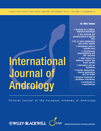Effects of nucleotides adenosine monophosphate and adenosine triphosphate in combination with L-arginine on male rabbit corpus cavernosum tissue
Summary
Purines and more specifically adenosine monophosphate (AMP) and adenosine triphosphate (ATP) have a strong relaxant effect on smooth muscle cells of the dog, rabbit and human corpus cavernosum, to approximately the same degree as nitric oxide (NO). However, purines are considered as modulators of erectile function rather than key mediators. This suggests that the use of purines combined with NO donors could be effective to treat some specific erectile disorders. The relaxation induced by the combination of l-arginine (Arg), a natural substrate for NO synthase, was assessed with a purine-nucleotide (AMP, ATP) on a rabbit corpus cavernosum model, to determine if these substances could potentiate each other’s effect. When a pre-contraction was induced by phenylephrine, AMP alone induced a 43% CC relaxation rate and ATP alone a 26% rate. The relaxation rate induced by Arg was lower in comparison (8% at 5.10−4 m vs. 25% at AMP 5.10−4 m and 15% at ATP 5.10−4 m). NO synthase inhibitor n-nitro-l-arginine did not modify the relaxing effect provoked by AMP suggesting that the mechanism of action of this nucleotide does not involve the NO pathway. The combination of Arg at 5.10−4 m with either AMP or ATP at different doses ranging from 5.10−4 to 10−3 m significantly enhanced the relaxing response reaching rates of 62 and 80% respectively, leading to a synergistic effect. The present data indicate that a ‘NO donor’ combined with an ‘adenosine donor’ could be an effective therapeutic approach.
Introduction
Although Nitric oxide (NO) is now accepted to be a key mediator in the erectile process of mammals, other agents may also play an important role (Burnett et al., 1992; Bush et al., 1992; Rajfer et al., 1992). An accumulation of evidence indicates that several purines and more specifically adenosine, Adenosine Triphosphate (ATP) and possibly Adenosine monophosphate (AMP) have a strong relaxant effect on smooth muscle cells of the dog, rabbit and human corpus cavernosum (CC), to approximately the same degree as NO (Takahashi et al., 1992a,b; Tong et al., 1992; Wu et al., 1993; Chiang et al., 1994; Katakoa et al., 2007; Calvert et al., 2008). Furthermore, the mechanisms responsible for this effect, which have been quite well identified, are predominantly independent from the NO pathway, suggesting that at least two different relaxing systems coexist in the rabbit and in human CC (Mantelli et al., 1995; Filippi et al., 2000; Katakoa et al., 2007). Interestingly, despite the fact that considerable study has been carried out with ATP and adenosine for the last 20 years, very few reports have described the effects of purines combined to another active molecule. Given that both adenosine and ATP have very short half-lives and mainly act as modulators of erectile function, there has been increasing interest in the ‘combination option’. However, further research is still required regarding this approach. Unfortunately, the intracavenous use of purines combined to another active substance has been, for men with severe erectile dysfunction (ED), the only path explored and the sole therapeutic option considered as being realistic (Chiang et al., 1994). Therefore, we were prompted to carry-out a study searching for an oral combination intended to treat specific subpopulations of patients with moderate sexual disorders and related to diseases with endothelial dysfunction. We hypothetized that AMP with arginine (Arg), the natural substrate for NO synthase, could be an interesting vasoactive combination and performed a preliminary in vitro study, aiming to investigate any potentiating effect between them. ATP was used as the referenced purine-nucleotide to allow for comparisons with AMP induced relaxing-effects.
Given the well-documented similarity between humans and rabbits regarding the neurovascular mechanisms involved in penile erection (Holmquist et al., 1992; Knispel et al., 1992; Cellek & Moncada, 1997), the study was subsequently performed on the rabbit CC.
Materials and methods
Strip preparation
Twelve male New Zealand white rabbits (weight 2.5–3.5 kg) were sacrificed by an overdose of sodium pentobarbital (Sanofi-Synthelabo, Paris, France) injected into the marginal vein of the ear. The penis was immediately removed at the point of attachment to the ischium, placed in KREBS-HENSELEIT buffer (Sigma, Saint Louis, MO, USA) to which was added sodium bicarbonate (Sigma) 25 mm, calcium chloride dihydrate (Sigma), 1.8 mm and sodium lactate (Sigma) 1 mm equilibrated with 95% O2 and 5% CO2 at 4 °C. The overlying tissues were dissected from the tunica albuginea. The tunica was opened and the CC was harvested. Each CC was cut transversely to obtain a strip of about 6–8 mm in length.
Tissue bath set up
Longitudinal strips were attached to force transducers using silk sutures. They were incubated in Krebs solution in 25 mL organ baths, equilibrated with 95% O2 and 5% CO2 and maintained at 37.5 °C. Isometric strip tension was recorded through an acquisition unit (MP30; Biopac, Goleta, CA, USA) connected to a computer. After mounting, each strip was allowed to equilibrate with a basal tension of 2 g for at least 2–3 h.
Drug and solutions
Phenylephrine (Sigma) pre-contraction was achieved by the addition of 8 μm to each bath. The maximum contraction to phenylephrine (plateau) was reached after 5 min. Drugs AMP, ATP (Interchemica, Bergheim, Germany) and Arg (Sigma) were administered either separately or in sequential combinations to the pre-contracted strips. The final bath concentrations were between 10−4 m and 10−3 m.
n-Nitro-l-arginine (l-NNA) at the dose of 5.10−4 m was administered to the strips before treatment with AMP (and not before treatment with ATP and l-arginine as this point has been well documented in the prior art (Mantelli et al., 1995; Filippi et al., 2000; Katakoa et al., 2007)).
Statistical analysis
Percentages of relaxation were compared using a variance analysis in repeated measurements (one-way anova) for AMP, ATP or Arg effects or using a t-paired test for comparing AMP or ATP groups with or without Arg. A value of p < 0.05 was considered significant in all tests. All results are expressed as mean ± standard error of the mean (SEM).
Results
The maximal relaxing effect after addition of active substances was measured at each stage (for each concentration) and was reached in approximately 1 min as shown in Fig. 1.
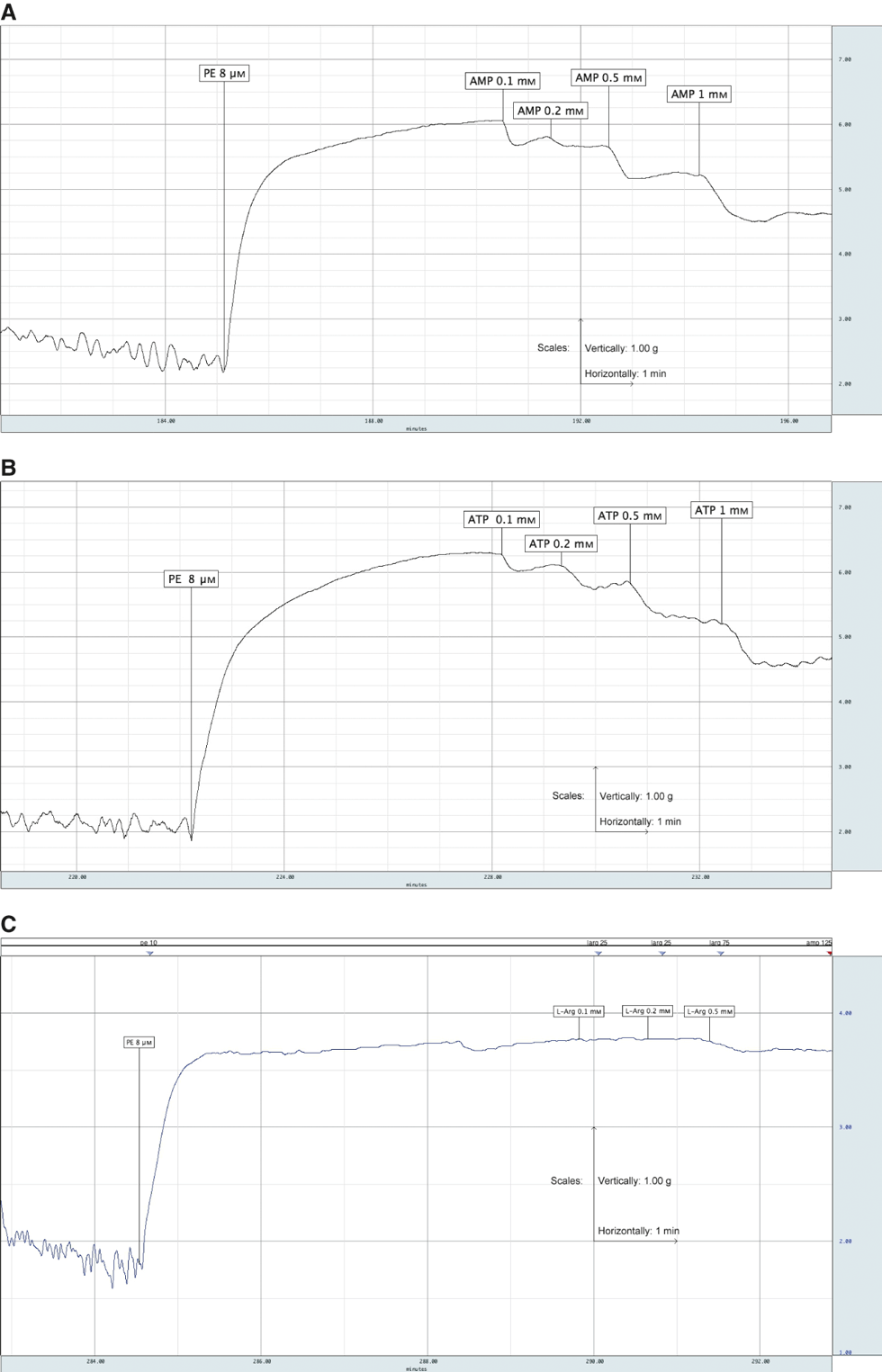
Dose-response curve over time for adenosine monophosphate (A), adenosine triphosphate (B), and l-arginine (C).
AMP, ATP and Arg alone -induced relaxations
AMP led to a significant (p < 0.0001) relaxing effect that reached a 25% rate at 5.10−4 m and a 43% rate at 10−3 m (n = 9). In comparison, ATP relaxation was lower, although also significant (p < 0.0001), reaching a 15% rate at 5.10−4 m and a 26% rate at 10−3 m (n = 7) (Fig. 2). The CC relaxation rate for Arg (n = 12) was much more limited, only 8% at 5.10−4 m in a concentration-dependent way (p < 0.001) (Fig. 3). Using l-NNA the relaxation produced by AMP at 5.10−4 m was reduced by a rate of only 7.8% (p = 0.0028) and at AMP 10−3 m of 9.2% (p = 0.0002).
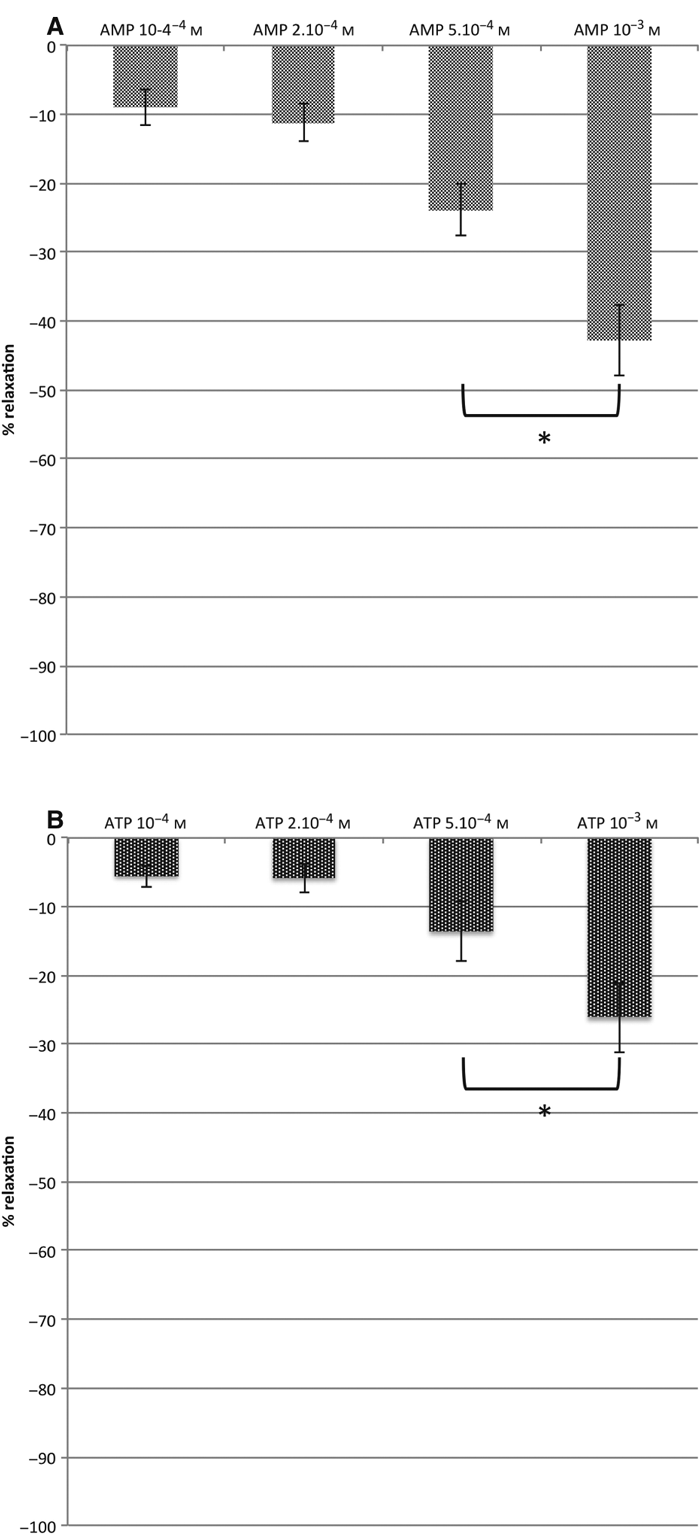
Adenosine monophosphate (A) and adenosine triphosphate (B) induced relaxing effect on the rabbit corpus cavernosum pre-contracted with phenylephrine (8 μm). Vertical bars indicate SEM (n = 9) (A), Vertical bars indicate SEM (n = 7) (B). n Indicates the number of strips tested. *p < 0.0001.
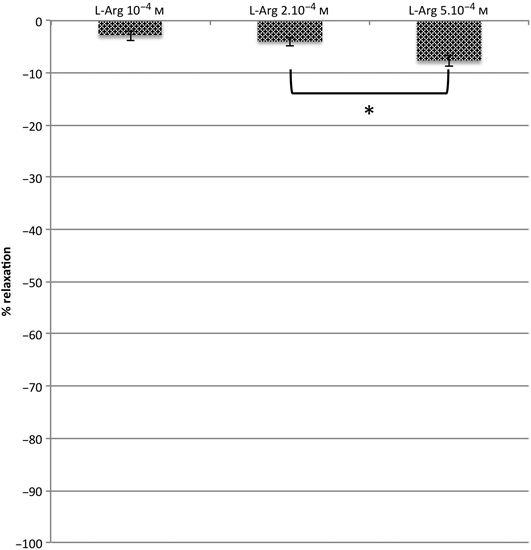
l-Arginine induced relaxing effect on the rabbit corpus cavernosum pre-contracted with phenylephrine (8 μm). Vertical bars indicate SEM, (n = 12). n Indicates the number of strips tested. *p < 0.001.
AMP-Arg -induced relaxation
After pre-contraction with phenylepinephrine, AMP (5.10−4 or 10−3 m) was first added, followed by the addition of Arg. Results can be seen in Fig. 4: AMP induced a significant (p = 0.0094) CC relaxation rate (30% at 5.10−4 m and 47% at 10−3 m) equivalent to the rate previously observed. When Arg (5.10−4 m) was added, the AMP induced relaxation rate was significantly further enhanced to 45%. At 10−3 m a 62% rate, CC relaxation was reached, compared with a 47% rate without Arg.
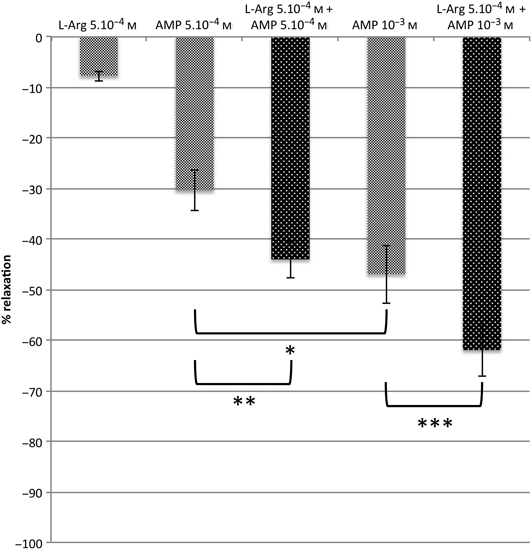
The adenosine monophosphate (5.10−4 and 10−3 m)/l-arginine (5.10−4 m) induced relaxing effect on the rabbit corpus cavernosum pre-contracted with phenylephrine (8 μm). Vertical bars indicate SEM, (n = 12). n Indicates the number of strips tested. *p = 0.0094, **p = 0.0209, ***p = 0.0395.
A synergistic effect was demonstrated with these two compounds as the final result was superior to the addition of the two effects obtained separately (8% rate for Arg alone). To confirm this fact, the response induced by Arg alone was subtracted from that induced by l-arginine with AMP and the result compared with that of AMP without Arg. Using paired tests and comparing AMP without l-arginine to AMP with Arg, there was a significant difference between the two whatever the AMP dose used (p = 0.0209 and p = 0.0395 respectively). These differences not only demonstrate the potentiating effect induced on the rabbit CC response when Arg was combined to AMP, but also the existence of a clear synergistic effect. Indeed, the sole addition of the relaxation induced by the two substances used separately was not sufficient to explain the increase of the AMP response in presence of Arg.
ATP/Arg -induced relaxation
Following the same methodology, Arg at 5.10−4 m induced a mild, although significant relaxation (p = 0.003) on the strips, which was very similar to previous results. ATP alone achieved a 34% CC relaxation rate at 5.10−4 m and a 57% relaxation rate at 10−3 m, which was a more powerful response than in the initial experiment (15% and 26% relaxing rates at the same dose respectively). In presence of Arg, the ATP relaxing effect was further enhanced (p < 0.0001) up to a 54% rate at 5.10−4 m and 80% at 10−3 m.
At ATP concentrations of 5.10−4 m and 10−3 m, a significant potentiating effect was obtained (p = 0.0007, p = 0.0055 respectively), whereas a synergistic effect was only observed at the dose of 10−3 m ATP (p = 0.030) (Fig. 5).
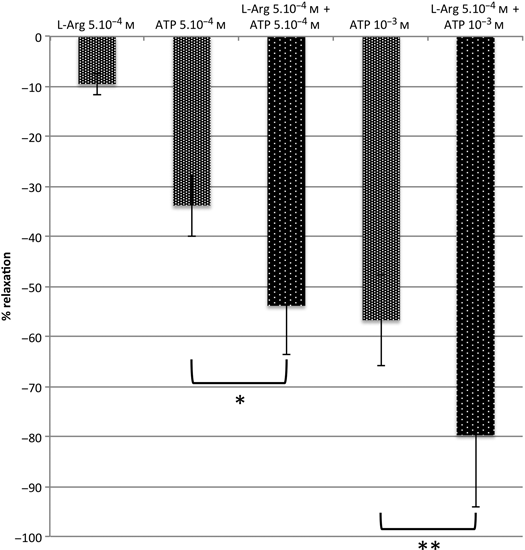
The adenosine triphosphate (5.10−4 and 10−3 m)/l-arginine (5.10−4 m) induced relaxing effect on the rabbit corpus cavernosum pre-contracted with phenylephrine (8 μm). Vertical bars indicate SEM, (n = 10). n Indicates the number of strips tested. *p = 0.0007, **p = 0.0055.
Discussion and conclusions
Arginine is the natural precursor of NO acting as a substrate for both endothelial and neural NO synthase (NOS). Several animal and human studies have demonstrated that high doses of Arg given orally could improve erectile function (Moody et al., 1997; Chen et al., 1999). Whether this effect is predominantly owing to the stimulation of endothelial NOS or neurogenic NOS has not yet been clearly determined. However, there is more evidence for a stronger and immediate impact of Arg on the endothelium rather than on the non-adrenergic and non-cholinergic nerves. High doses of exogenous Arg can restore NOS activity in conditions with endothelial dysfunction, such as ageing, tobacco addiction, atherosclerosis and diabetes mellitus (Pieper & Dondlinger, 1997; Göçmez et al., 2005). Yildirim et al. (1999) showed that long- term oral administration of Arg to diabetic rabbits increased endothelium-dependent relaxation of rabbit CC, but had no effect on the neurogenic CC relaxation of these animals. This is consistent with the excellent bioavailibility of Arg after oral absorption; Arg rapidly enters the circulation, reaches a plasma peak 40–60 min after intake (pharmacokinetics are similar in the rat, the pig, the rabbit and humans) and slowly decreases during the next 2–4 h (Bode-Boger et al., 1998; Tangphao et al., 1999; Wu et al., 2007). It is thus clear that upon administration Arg has a prolonged contact with the vascular endothelium prior to any other tissue. Fortunately, Arg is also very well tolerated and can be administered at high dosages (Barbul, 1986). As the incidence of sexual dysfunction increases because of ageing, diabetes or atherosclerosis, Arg remains, in our view, a molecule of great therapeutic interest. However, in our experience, Arg is more effective when combined with another vasoactive substance (Lebret et al., 2002). We selected purines as the best potential partners for Arg and among them AMP for the reasons explained below.
The mechanisms by which purines are involved in erectile function have been exhaustively studied for the last 20 years and were not the focus of our study. They can briefly be recapitulated as follows:
The role of purines in the erectile process was first suspected by Burnstock (1972) and Benson et al. (1980). In the nineties, a series of in vitro and in vivo experiments performed by different authors (Takahashi et al., 1992a,b; Tong et al., 1992; Wu et al., 1993) clearly demonstrated that adenosine and ATP have a strong relaxing effect on the rabbit and dog CC smooth muscle, independently from the NO pathway and from the adrenergic tone. Subsequently, an array of evidences (Chiang et al., 1994; Mantelli et al., 1995; Filippi et al., 2000; Katakoa et al., 2007) indicated that A2 receptors subtypes were involved in the erectile process via adenosine stimulation and activation of the cyclic AMP pathway. Not only this mechanism of action was presumed to be predominant for adenosine, but under physiological conditions also applicable to adenosine nucleotides; indeed, upon action of ecto five nucleotidases that are present on the surface of cell membranes, ATP, ADP and AMP are responsible for the continuous release of adenosine, acting as natural ‘adenosine donors’ and A2 receptor agonists. In an in vitro study, Calvert (Calvert et al., 2008) showed that ATP can also act as a P2Y receptor agonist; however, in vivo this path is usually considered of secondary importance. Regarding AMP, only Chiang (Chiang et al., 1994) before us studied the effect of this nucleotide on the rabbit CC. He concluded that AMP and ATP were equally efficient and using field stimulation that AMP effect was independent from nitrogenic transmission. As he did not study the role of endothelium nitrogenic production using NO synthase inhibition reason why, in, this study, we tested the impact of l-NNA on the CC relaxation induced by AMP. It appeared to be also independent from the endothelium NO pathway.
Adenosine and ATP have extremely short half lives (<5 sec) and thus can only be used intra-cavernously. Although the intracavernous combination of Arg with ATP does make sense, we were more interested in studying AMP relaxation effects on the rabbit CC and in comparing them to those of ATP. Firstly, among purine-nucleotides, only AMP is available for oral use: the half life of other nucleotides is much too short for them to survive in the gastrointestinal tract and their bioavailability is very poor after oral administration. Secondly, AMP can cross the gastrointestinal barrier and go intact into the bloodstream (Malmary-Nebot et al., 1979). Thirdly, AMP has been marketed under different trade names for various applications (porphyria, venous disorders etc.), can be given orally at high dosages and with only very mild side-effects. Fourthly, AMP and arginine pharmacokinetics are very close, with a plasma peak between 30 and 60 min for both, followed by a 2 h decrease. Last but not least, similarly to Arg, AMP, acting via adenosine, has a predominant vascular effect (observable at high dosages) especially in diseases in which endothelium-dependent relaxation is impaired, such as, for example, in diabetes. Gür and Ozturk studied the response to adenosine on CC strips from diabetic and non-diabetic patients: CC strips showed enhanced sensitivity and improved response to adenosine-induced relaxation in preparations from diabetic men compared with non-diabetic men preparations (Gür & Öztürk, 2000). Therefore, there are numerous arguments, which indicate that Arg and AMP could form an interesting vasoactive combination to treat some specific sexual disorders. The first stage in our search was to assess the value of this combination in a standard pre-clinical experiment.
The results of this study are consistent with those previously reported by other authors serving as a reference (Takahashi et al., 1992a,b; Tong et al., 1992; Wu et al., 1993; Chiang et al., 1994; Katakoa et al., 2007; Calvert et al., 2008). They show that AMP cause a dose-dependent relaxation on pre-constricted male rabbit CC strips to about the same extent as ATP. l-NNA an inhibitor of NO synthase had a very modest impact on the relaxation induced by AMP. This is consistent with previous observations indicating that purines act independently from the NO pathway. It also supports the idea of at least two parallel erectile mechanisms. Our most interesting finding was that l-arginine, a natural substrate for NO synthase and purine-nucleotides (AMP, ATP) acting like adenosine donors, can potentiate each other’s activity leading to a significant synergistic effect. This synergy suggests that the concomitant stimulation of the two mechanisms mentioned above can affect erectile response.
Given the complexity of the underlying mechanisms involved in male erectile dysfunction and the possible existence of several causes for the disorder, it would be unreasonable to expect a single agent or just one family of compounds to be the sole option in the treatment of ED. It is more likely that a combination of agents could be required and could significantly increase the rate of successful therapy. The results of this preliminary study indicates that NO ‘donors’ and ‘adenosine donors’ combinations could be targeted in the future as an effective therapy for ED. Arginine and AMP used alone in the human are very well tolerated, even at high dosages, with no deleterious hemodynamic effects. Clinical studies are required for further assessment of their combined use and selection of the subpopulations that could benefit from this therapeutical approach, in particular those with an underlying endothelial dysfunction disease. Therapeutic strategies with arginine to optimize PDE5 inhibitor therapy in patients who do not respond to PDE5inhibitors have been proposed. Adenosine donor and NO donor combinations could also play a role in this application. Further research in pre-clinical studies using the same or a different animal model should be implemented.



